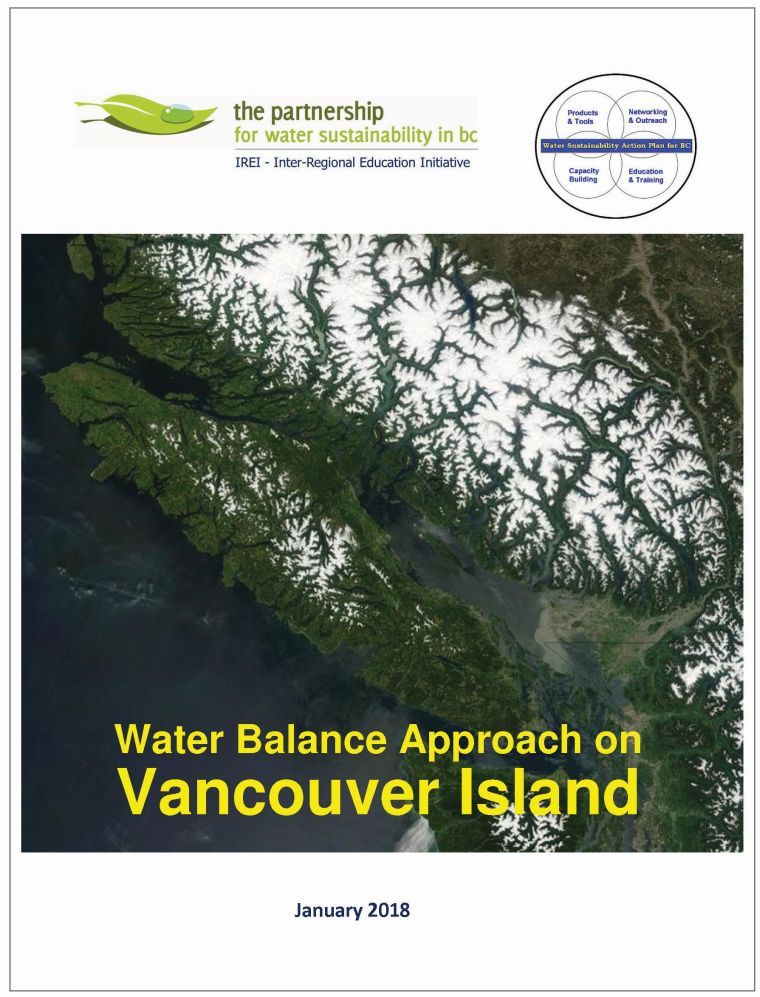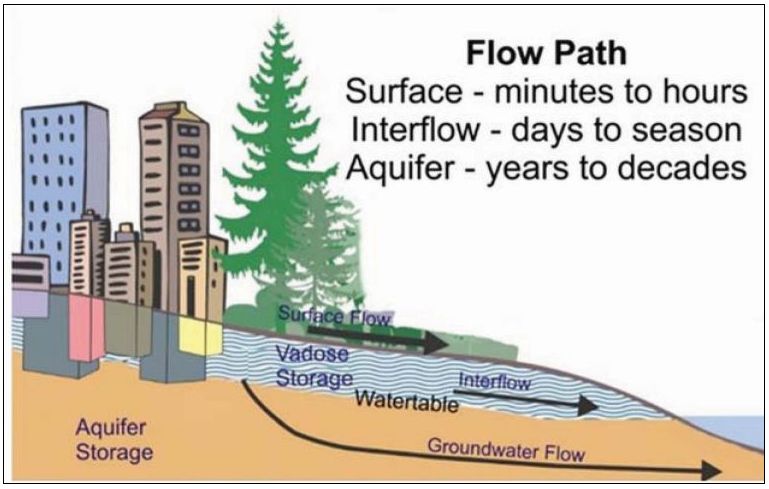BRITISH COLUMBIA IS AT A TIPPING POINT: The time has come to transition drainage engineering practice from “voodoo hydrology” to a water balance approach branded as “Sustainable Watershed Systems, through Asset Management”
Note to Reader:
In January 2018, the Partnership for Water Sustainability in British Columbia released the 7th in the Watershed Case Profile Series. A Water Balance Approach on Vancouver Island is built around three regional Water Balance demonstration applications.
The Watershed Case Profile Series is unique. The series showcases and celebrates successes and long-term ‘good work’ in the local government setting in British Columbia. The spotlight is on champions in communities which are breaking new ground and establishing replicable precedents.
Storylines touch lightly on technical matters, yet are grounded in a technical foundation. The objective in ‘telling a story’ is to engage, inform and educate multiple audiences – whether elected, administrative, technical or stewardship. Stories in the series are presented in a magazine style to make it easier to read, comprehend and absorb technical information. Stories are designed to connect dots.

Desired policy outcomes in transitioning drainage practice from “voodoo hydrology” to the Water Balance Methodolgy would be less flooding, less stream erosion, more streamflow when needed most ….and reduced life-cycle costs and risks!
 “Regulatory objectives linked to Asset Management for Sustainable Service Delivery: A BC Framework would make it possible to transform drainage engineering practice at the site scale,” states Kim Stephens, Executive Director, Partnership for Water Sustainability in BC. “The BC Framework sets a strategic direction that refocuses business processes on outcomes that reduce life-cycle costs and risks.”
“Regulatory objectives linked to Asset Management for Sustainable Service Delivery: A BC Framework would make it possible to transform drainage engineering practice at the site scale,” states Kim Stephens, Executive Director, Partnership for Water Sustainability in BC. “The BC Framework sets a strategic direction that refocuses business processes on outcomes that reduce life-cycle costs and risks.”
“Alignment with the BC Framework would enable and support the transition of drainage practice from “voodoo hydrology” to a water balance approach branded as Sustainable Watershed Systems, through Asset Management.”
Voodoo Hydrology
Drainage engineering practice for servicing of land still relies on very simple formulae and methodologies to calculate peak rates of flow. Such analyses are empirical, not science-based.
Andy Reese coined the term Voodoo Hydrology in 2006 to describe drainage engineering and stormwater management practice.
 “We have for years relied upon common design methodologies and trusted their results. But, should we? It is an inexact science at best. We rely on judgment and guesswork,” states Andy Reese. He is an American water resources engineer, writer, speaker & textbook author. “Perhaps, if we make enough estimates of enough factors, the errors will average out to the right answer. This is where voodoo really comes in handy.”
“We have for years relied upon common design methodologies and trusted their results. But, should we? It is an inexact science at best. We rely on judgment and guesswork,” states Andy Reese. He is an American water resources engineer, writer, speaker & textbook author. “Perhaps, if we make enough estimates of enough factors, the errors will average out to the right answer. This is where voodoo really comes in handy.”
Opening Minds is a Challenge
“Standard engineering practice only considers surface runoff in analyses,” continues Kim Stephens. “Yet the flow of rainwater from cloud to stream is comprised of three water balance pathways: surface runoff; shallow interflow; and deep groundwater. The other two pathways are ignored by designers. Time, a critical factor, is also ignored.
“Among land and drainage practitioners, how water gets to a stream and how long it takes, is not well understood. There is a growing awareness of what ought to be done differently. But missed opportunities ‘to get it right’ persist. Opening minds to accept changes in practice is a challenge.”

What the reader will learn from this Watershed Case Profile
- more flooding;
- more stream erosion; and
- less streamflow when needed most.
Why is this still happening 16 years after the provincial government introduced the Water Balance Methodology, and set a whole-system direction for urban hydrology and drainage engineering in this province, with release of Stormwater Planning: A Guidebook for British Columbia?

Context for Action
British Columbia is at a tipping point. A provincial policy, program and regulatory framework is in place to help local governments bridge the gap between policy and action (i.e. a new standard of practice). The first step is to acknowledge that there is a problem with standard practice, and recognize that immediate action is required to remedy the problem.

From Awareness to Action
- apply science-based understanding;
- establish watershed-based performance targets; and
- downscale those performance targets to the site scale.
This Watershed Case Profile presents capsule summaries of each demonstration application. But it does more than that. It provides an explanation of the problem and the solution. It then closes with an overview of Sustainable Watershed Systems, through Asset Management. The latter foreshadows a potentially powerful regulatory driver for transforming drainage engineering practice at the site scale.
The table below is a synopsis. It distills the essence of each section into a succinct statement. These create a storyline. Readers should pause and reflect on them before reading the story itself.


